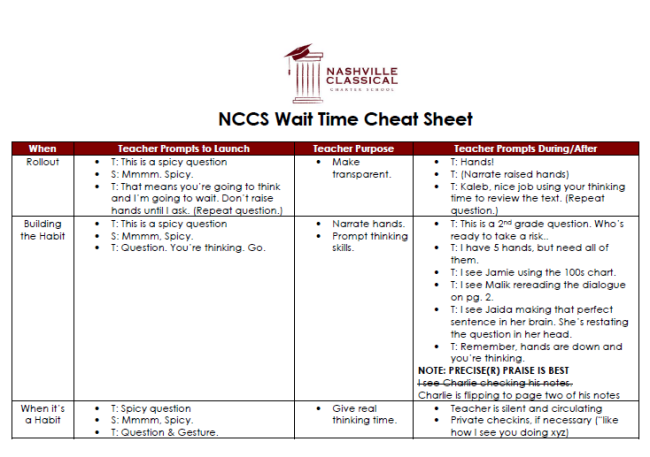04.17.15Implementing Wait Time: Guest Post by Charlie Friedman
 Amazing Engaging Academic workshop in Denver this week. We loved talking about the craft of teaching with teachers from Denver, Albuquerque, Las Vegas, Charlotte and a score of other places. One of the highlights came during a break. I noticed that Charlie Friedman, the principal of Nashville Classical, was writing, and I asked what he was up to. Turns out he was building an implementation guide for his teachers to use in rolling out Wait Time in their K, 1, 2 classrooms. (see above). He wanted to give teachers guidance on a consistent way to signal quickly, efficiently, and transparently to students that they would get plenty of time to think before answers would be taken and to teach students what to do with the the Wait Time they got–to think deeply, go back to the text, etc. It was pretty amazing and reminded that the value of any idea is only as high as its execution. I asked Charlie to blog about it. Here’s what he wrote:
Amazing Engaging Academic workshop in Denver this week. We loved talking about the craft of teaching with teachers from Denver, Albuquerque, Las Vegas, Charlotte and a score of other places. One of the highlights came during a break. I noticed that Charlie Friedman, the principal of Nashville Classical, was writing, and I asked what he was up to. Turns out he was building an implementation guide for his teachers to use in rolling out Wait Time in their K, 1, 2 classrooms. (see above). He wanted to give teachers guidance on a consistent way to signal quickly, efficiently, and transparently to students that they would get plenty of time to think before answers would be taken and to teach students what to do with the the Wait Time they got–to think deeply, go back to the text, etc. It was pretty amazing and reminded that the value of any idea is only as high as its execution. I asked Charlie to blog about it. Here’s what he wrote:
At the TLAC Engaging Academics Conference, our team was fired up about Wait Time. However, as we practiced, I noticed three interesting things:
- We had different cues to signal that we wanted our scholars to expect Wait Time. In other words, we struggled to make Wait Time transparent.
- We struggled to isolate our purpose. That is to say, sometimes we wanted to push student motivation, but the phrases that we kept in our back pockets were better suited to praise student thinking. Not a bad thing, but underscored the importance of at-bats to build muscle memory around different types of Wait Time.
- Our classrooms were in different places with respect to teacher comfort with Wait Time. Some used it regularly. Others only narrated motivation. Everybody could be better. In classrooms where it was a habit, we wanted to build a space for real thinking time. Across the board, we wanted to systematize it so that teachers didn’t need to start from scratch each year. If we can build the habit in K and 1, then we can build upon the habit in 2nd and 3rd grade.
To make Wait Time a habit for teachers and for students, we designed a PD that would include 3 steps (Right now, respect and apologies go to the brilliant Charles Duhigg and his book, The Power of Habit).
- A cue for students (Teacher says ‘Spicy Question’ meaning its fun and rigorous and we are going to think before we answer).
- A routine (Students say “Mmm, Spicy” and Wait Time begins).
- A reward (Hands are raised, someone’s called upon, and teacher praises).
We made a cheat sheet for teachers and broke our cheat sheet into prompts that would launch Wait Time (cues), prompts during Wait Time (the routine) and prompts for after Wait Time (the reward). And we identified different phrases for different times during the gradual release of the system. Also, as we worked, we realized that there were infinite phrases we could use at the different times. Each phrase has its own impact so we tried to choose a select few.
If simplicity and clarity were key to sharing the technique, I think the key to making Wait Time a school-wide norm is to lather, rinse and repeat. Or, to observe bright spots, codify them, and share them. As a staff, we believe that writing things down makes them real. Having this cheat sheet equips our teachers and leaders with clarity. It won’t be perfect right away (my guess is that this cheat sheet will become better just by virtue of sharing it), but we have clarity and – like a child whose hand is always raised – we can’t wait to act.
Here’s a PDF of Charlie’s Cheat Sheet:

Doug, thank you for a wonderful 2-days. You left us wanting more!
Charlie, thank you for allowing Doug to share your cheat sheet. It is so amazing how educators share for the betterment of all students.
Our team enjoyed meeting and sharing ideas with other educators from around the US.
Grant Schmidt, Hanover School District
Colorado Springs/Fountain, Colorado
How much of a student response should be “Mmm, spicy.” The whole class?
ericpollock@yahoo.com